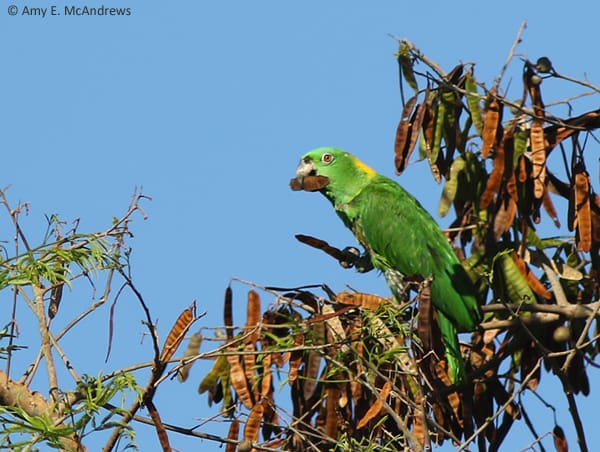Yellow-naped Amazons: Research and Outreach
The Yellow-naped Amazon (Amazona auropalliata) is seriously declining in most of its range. Beginning in 2023, Fundación Zoológica de El Salvador (FUNZEL), with support from the WPT, began assessing the wild status of Yellow-naped Amazons on Isla de la Tasajera in El Salvador, collecting data on sites important for feeding, breeding and roosting. Included in these investigations were interviews of cashew growers, who gave information on the Yellow-naped Amazon’s impact on their crops. Another element involves local community members and Guards from the ANP Jaltepeque Complex, community leaders and the Ministry of Environment and Natural Resources (MARN) completing surveys and other fieldwork.
In addition to completing field research and monitoring the birds, a nursery with native trees has been established through training provided by the Faculty of Agronomic Sciences of the University of El Salvador. Research has found that the birds, for the 2023 season at least, do not have an appreciable negative effect on cashew production. Evidence for poaching was also uncovered. The team’s ongoing work is expanding to complete full breeding season nest monitoring and vigilance patrols to reduce poaching. Also included will be training local volunteers and national biologists in nest access and monitoring skills.
In a new initiative, WPT-supported Green Island Challenge in the Bay Islands, Honduras, is expanding its education program with island-specific lessons focused on the environment, parrots, and fostering a deeper connection to the land. In addition to their educational efforts, Green Island Challenge is conducting anti-poaching patrols, nest box installations and parrot counts.
IUCN/CITES Status: Critically Endangered / Appendix I
Population: About 2600
Range: A.a. auropalliata: Pacific slope from Oaxaca, Mexico to NW Costa Rica. A.a. parvipes: Mosquitia of Honduras and NE Nicaragua. A.a. caribaea: Bay Islands, Honduras
Natural history: The Yellow-naped Amazon favours deciduous forest, pine-oak woodland, gallery forest along waterways, arid to semi-arid savanna woodland, and dry scrubland with remnant woodlots or scattered trees. Birds are found in pairs or flocks with larger gatherings at communal roosts and feed areas. They feed on seeds of Cochlospermum, Curatella, figs and ripening Terminalia fruits. Bay Island birds feed on pine cones.

